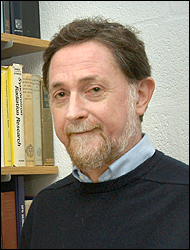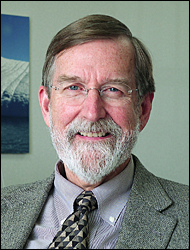Making the Call: How Referees Help Decide Which Science Papers Get Published
April 28, 2009
 enlarge
enlarge
Peter Johnson, chair of Brookhaven Lab's Condensed Matter Physics & Materials Science Department and an American Physical Society's Outstanding Referee
Most good ideas don't just fall out of the sky. Even astronomers, who look up often, base their new ideas, theories, and discoveries on previous work in the field. While mainstream media might highlight a scientific discovery, the details are often omitted for the general public. These details, which help to fuel future innovations, get published in more subject-specific journals.
"Having work published in scientific journals is the formal mechanism by which scientists communicate and show our worth to fellow scientists. We refer to the papers published in journals to develop our own ideas," said Peter Johnson, chair of Brookhaven Lab's Condensed Matter Physics & Materials Science Department.
But having work published in scientific journal has other benefits, Johnson explained. "Scientists are often assessed based on the number of papers they have had published. When recruiting or fundraising, that number is a good indicator of how established someone is, or how good an investment someone is," he said.
Gene Sprouse is editor-in-chief of the American Physical Society's (APS) Physical Review, a family of journals first founded in 1893 to highlight developments in physics. According to Sprouse, "Each year, we receive about 35,000 submissions for the Physical Review journals. About 18,000 of those submissions are published."

Gene Sprouse, editor-in-chief of the American Physical Society's Physical Review (Photo credit: Bob Kelly)
"Part of the editor's job is to find the right person to referee," Sprouse said. With so many papers being submitted, journal editors work with "referee" scientists who assess the scientific quality, timeliness and accuracy of the paper, and give advice to the editor about acceptance or rejection. "Everyone who submits research has an obligation to referee for the journal and most of the scientific community takes refereeing seriously and does it well," he added.
Aware of this obligation, Johnson has refereed for numerous journals, including the Physical Review. In fact, Johnson and ten other Brookhaven scientists were selected by APS as "Outstanding Referees" among its 44,000 referees around the world. These referees were recognized for their efforts to maintain the journal's high standards by improving the quality and readability of its articles.
"I ask myself several questions when I referee," Johnson said. "Does this work provide new insight? Is it new information I might be interested in? Are there any obvious flaws? Has the author explained everything in sufficient detail?"
If as a referee Johnson feels that a paper he has reviewed should not be published, he must submit a statement explaining that decision to the journal editor. If he decides that a paper is suitable for publication but is not 100 percent ready, he must make suggestions for improvement. Authors can appeal a referee's decision, but ultimately, the journal's editor decides what gets published and what does not.
"Referees are given advance insight into work because they're seeing it before the rest of the community does," Johnson said. "I look for things that leave me thinking, 'Gee-whiz,' or, 'Wow.' If something I read is really stimulating, I want to go out and try other things and maybe go in new directions."
After all, most good ideas don't just fall out of the sky.
The American Physical Society has named 11 Brookhaven scientists as "Outstanding Referees." They are: Mark S. Hybertsen, Peter D. Johnson, William J. Marciano, Arnold R. Moodenbaugh, Frank Paige, Ronald Pindak, Boris Podobedov, Stephen M. Shapiro, John M. Tranquada, Alexei Tsvelik, and Richard E. Watson.
2009-1182 | INT/EXT | Newsroom









